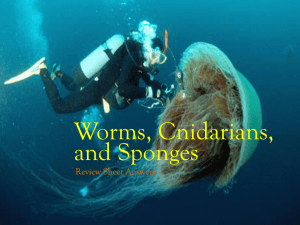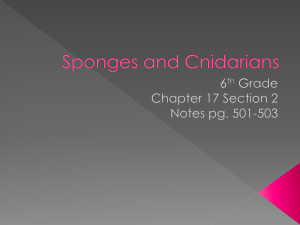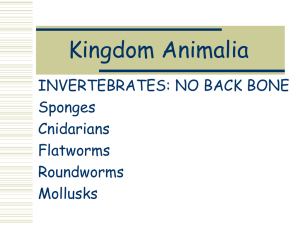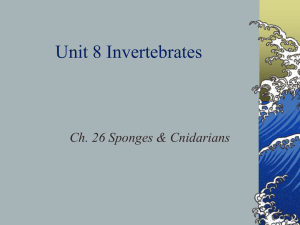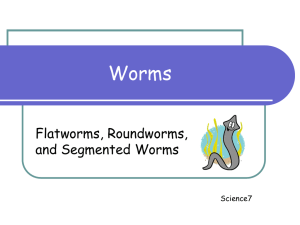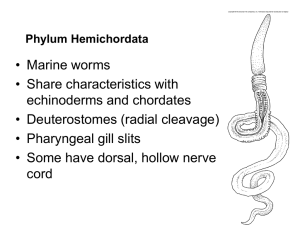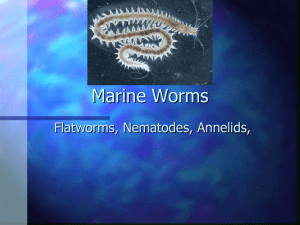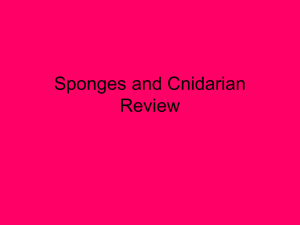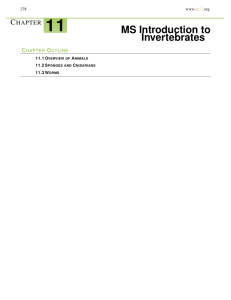Sec 1.4 Worms
advertisement
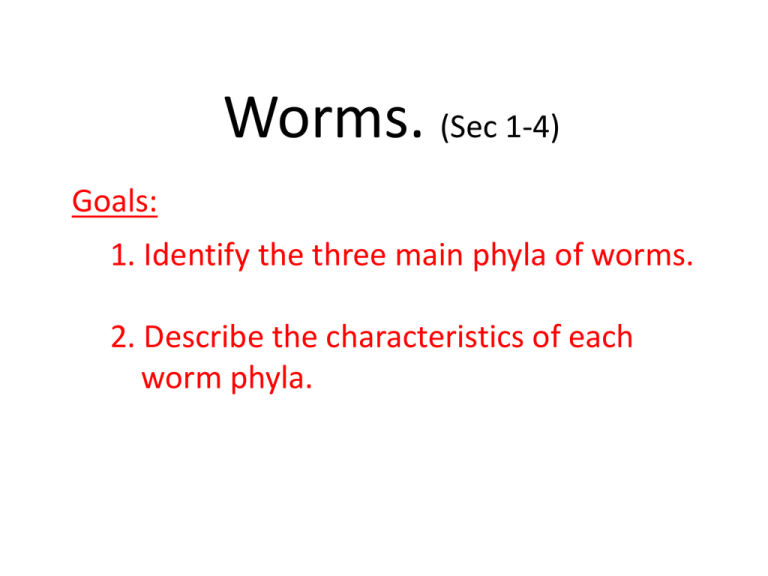
Worms. (Sec 1-4) Goals: 1. Identify the three main phyla of worms. 2. Describe the characteristics of each worm phyla. Characteristics of Worms. 1. Flatworms (Platyhelminthes) 2. Roundworms (Nematoda) 3. Segmented worms.(Annelida) Characteristics of Worms… Body structure -worms are invertebrates with long narrow bodies without legs -worms have bilateral symmetry -worms have a head, tail, tissue, organs and organ systems. Characteristics of Worms… Nervous system -the simplest organisms with a brain. -have sense organs that are sensitive to light, touch, and vibrations. Characteristics of Worms… Reproduction -Exhibit both sexual and asexual reproduction. -Many species have separate male and female individuals. --Other species have one individual with both male & female organs. -Some reproduce asexually by breaking into pieces. Flatworms Flatworms - (tapeworms, planarian and flukes) - flat and soft like jelly --Many are parasites; who takes food from its host --Some flat worms are free living organisms that glide over rocks, or swim in ponds. Flatworms Planarians Flatworms -Planarians -Free living flatworms that are -scavengers: feed on dead or decaying material. --Also predators that will attack smaller animals. -Have Eyespots: two dots that detect light. Also have cells that can pick up odors. Tapeworms Flatworms -Tapeworms -Parasitic flatworm. - body is adapted to absorbing food from host’s digestive system. -Many can live in human hosts. --Can live in more than one host during their lifetime. (Fig 22. page 29) Roundworms Roundworms (e.g: Hook worms, C.Elegans) --Can live in nearly any moist environment. -Difficult to see, but abundant. -Some are free-living, some are parasites. --Unlike flat worms, cylindrical. --have a very efficient tube-like digestive system. Segmented Worms Segmented worms -earthworms, leeches and some sea floor worms -Body Structure --made up of many linked sections called segments -have a long string of nerve tissue called a nerve cord. -have a digestive tube, one way with two openings -Circulatory system --Closed circulatory system: blood vessels. Earthworms Earthworms in the environment -earthworms tunnel for a living, they come out on damp or raining days -seek leaves and decaying matter to take underground -need to keep skin moist, -obtains oxygen through moisture on its skin. -Earthworms help loosen the soil, and provide fertilizer. Names: _______________________ Worms flow chart WORMS Round Worms (Nematoda) . . Tape worms . C. Elegans . . Earth worms Names: _______________________ Sponges, Cnidarians and Worm Comparison Chart 1. Animals 2. Phylum 3. Structure 4. Symmetry 5. Obtain food 6. Movement 7. Reproduce 8. Examples Name: _______________________ Comparing Worms, Cnidarians, and Sponges Answer the following questions. 1. What is the difference between the three types of worms? 2. What characteristics are common to all worms? 3. Describe how the stinging cells of cnidarians are used. 4. Describe two forms of cnidarians. 5. Describe how the immature and adult forms of sponges look. 6. How does a sponge obtain food and water? 7. In what ways are cnidarians more complex than sponges? 8. In what ways are roundworms more complex than cnidarians? Sponges, Cnidarians and Worm Comparison Chart 1. Animals Sponges 2. Phylum Annelida 3. Structure polyps, medusa, tentacles, and mouth 4. Symmetry Bilateral Symmetry 5. Obtain food 6. Movement Parasitic, Scavenger, or Predator. No movements 7. Reproduce 8. Examples Sexually and Asexually Planarian, tapeworms, and flukes. Comparing Worms, Cnidarians, and Sponges 1.What is the difference between the three types of worms? Flatworms are flat parasites that obtain food from a host and have a digestive system with only one opening. Roundworms are cylindrical and have a one-way digestive system that is open at both ends, like a tube. Segmented worms have bodies made up of linked segments, a one-way digestive system, and a closed circulation system with blood vessels and a heart. 2.What characteristics are common to all worms? Flat, round, and segmented worms all have tissues, organs, and organ systems. They are the simplest organisms with brains. They also have bilateral symmetry, giving them heads and tails. 3.Describe how the stinging cells of cnidarians are used. Cnidarians are characterized by stinging cells that inject venom. Stinging cells are used by cnidarians to capture prey and to defend themselves. 4.Describe two forms of cnidarians. Cnidarians may be either polyps—attached to the bottom like sea anemones—or medusas, free-floating "jellyfish.“ 5.Describe what the immature and adult forms of sponges look like. An immature larva is a hollow ball of cells that swims through the water. Eventually the larva attaches to a surface and develops into a nonmoving adult sponge. The body of an adult sponge has an irregular shape and no symmetry. 6.How does a sponge obtain food and water? Water enters through pores and flows into a central cavity. Whip like collar cells bend back and forth to move water through the sponge. Water finally exits through large openings called oscula. A sponge feeds by using collar cells to strain particles from the ocean water. Jellylike cells digest and distribute food through the sponge. 7.In what ways are cnidarians more complex than sponges? Cnidarians are more complex than sponges because cnidarians have specialized tissues, while sponges have only specialized cells. 8.In what ways are roundworms more complex than cnidarians? Roundworms are more complex than cnidarians because roundworms have organs and organ systems, while cnidarians have only specialized tissues.
